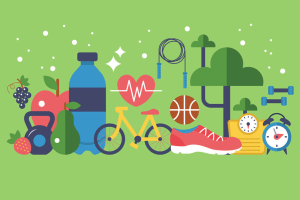
Are you still sticking to your New Year's Resolutions?
If you are, you're one of the few. And if you're not, you're not alone.
Whether you're still going strong or have waivered on your goals, these 6 steps will aid you in making sure you actually achieve your goals.
Setting a goal is one thing, and often when you fall off the path of your goal you think it's because you lack motivation. What most people don't realize is that it's not motivation (or the lack thereof) that prevents them from achieving their goals...it's lack of clarity.
Perhaps it's clarity on what your goal is to begin with (and if that's the case, check out our blog on goal setting here), or maybe it's lack of clarity on what habits you need to create in order to actually get you to your goal.
If you've set a WHY SMART goal but have not established the habits you need to focus on, take your goal and figure out what type of person you need to become to achieve that goal. For example, if your goal is to lose 50 lbs by the end of the year you probably need to be someone committed to your health in order to reach that goal. So what habits does someone have who is committed to their health?
- Taking supplements?
- Exercising 3 times a week?
- Tracking food?
- Eating more fruits and veggies?
- Drinking more water?
Once you figure out what habits you need to become the person who is able to reach your goals, now you've got to start implementing them. Follow the steps below to implement the habits you need, and be able to stick with them long term.
Step 1: Focus on ONE new habit
It can be tempting to hop into your habits all at once, quitting your bad habits cold turkey, but it is not the most effective way to do it for a few different reasons, the biggest one being: it's challenging!
If you try to do everything at once it can become overwhelming, and then when you inevitably fall off on one of the habits it can become discouraging which may lead to falling off on more and more habits until you decide to "just give up."
Starting with one small habit, mastering that habit, and then adding on another is a much more sustainable and much less stressful way of creating new habits. Pick a habit you know you can commit to, once you master it the compound effect will take over and before you know it you'll have a whole host of new habits.
Step 2: Habit stack
You haven't gotten this far in life without establishing any habits...in fact, most of the habits you have you don't even realize you have! For example: brushing your teeth. Most people brush their teeth first thing in the morning, maybe after you wake up and go to the bathroom. And you've done it the same way, in the same order for YEARS without even realizing it.
One of the best ways to establish a new habit, according to James Clear author of Atomic Habits, is to habit stack. Habit stacking is anchoring your new habit to an already well-established habit.
Here's an example: If one of your goals is to take your supplements consistently, habit stacking could mean you place your supplements next to your coffee pot. When you get your daily coffee, seeing the supplements will trigger you to take them.
Step 3: The 2 minute rule
Sometimes the idea of your new habit can be overwhelming, like working out 3x a week, and can prevent you from even taking the first steps to move forward. If this sounds familiar, use the 2 minute rule. Commit to the first 2 minutes of your new habit. For working out, maybe that commitment is getting dressed in your workout clothes, or tying your sneakers, or even working out for 2 minutes to start. If you commit to just the first 2 minutes and those become a natural habit, eventually you'll think "you know, I'm already dressed so I might as well work out," or "I've been working out for 2 minutes, I might as well keep going."
Before you know it, those 2 minutes will become a part of your routine which will automatically trigger your new habit.
Step 4: Make a plan for obstacles
We tell our clients this all the time: life is always going to happen. Obstacles will occur, so will setbacks, and the reason why so many people stop moving toward their goals when they meet obstacles is because they don't have a plan for when obstacles happen. When you know in advance what your obstacles are, you can take preventative action to overcome them.
Here are some common obstacles:
- Time
- Pain
- Weather
- Space
- Cost
- Self-consiousness
If you prepare and anticipate that these obstacles will come, you won't be blindsided by them. This is called "If-then planning," here is the formula: if x obstacle occurs, then I will do y.
Here are some examples:
- If I don't have time to prepare my meals tonight, I will wake up 30 minutes earlier and prepare my meals before anything else.
- If I have a really bad day at work and don't feel like working out, I will still walk briskly for at least 15 minutes.
- If I don't have the money for a coach, I will stick with a budget in areas that I can cut from and allocate the rest for my health.
Step 5: Align enviroment for success
Sometimes the biggest challenge to reach your goals is your environment: you've committed to eating healthy but still have the cookies in the cabinets, you've committed to getting up an hour early each day but your alarm clock is right next to your bed and too easy to snooze.
One of the biggest ways to ensure you stick to your habits is to align your environment with your goals. Your environment doesn't just mean your home, it could also mean picking a fitness facility on the way home from work instead of accross town, it could mean bringing your own water bottle to work and keeping it at your desk instead of having to walk to the water fountain down the hall.
Essentially, aligning your environment is removing friction from your habits. If you always have temptations to eat cookies at night, don't buy cookies. If you are trying to cut back on coffee, get a smaller coffee pot. The more you can align your environment with your goals, the easier it will be to reach them.
Step 6: Reward small milestones
Where most people go wrong with rewards is they pick a reward that is the antithesis of the person they need to become in order to reach their goals. When it comes to weightloss, many people will say "if I work out 3x this week, I'll go get ice cream" or something along those lines.
Now, there's nothing wrong with ice cream, however using it as a reward goes against your ultimate goal. A reward that would align with your goals is, "if I work out 3x a week for a month I will go get a massage."
When picking your rewards, strive to pick something that coincides with your goals. If your goal is health focused, pick a health focused reward: something that you will enjoy but won't move you away from your goals.
We hope this helps you continue to move towards your goals, and if you need more support don't hesitate to give us a call at 302-689-3489.


